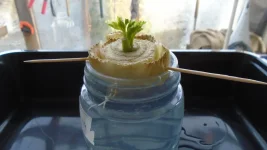I'm finding this whole subject fascinating, and intend to follow all reports closely. As
@blenor 2 has clearly attained far more knowledge than me, I look forward to his reply as well.
I do have a thought about the watering you mention, as well as home made fertiliser though, and although I have never even contemplated using hydroponics, my thoughts would be that the water used would need to be 1) moving, and 2) changed every week or two - a bit like water cress. For this I would consider a chamber for the plants to grow in, and another sub chamber to house a small pump - then if anything does start building up in the water, it will automatically clean.
Although I am not sure if you grow Comfrey in America, it does make a super liquid feed, as do our stinging nettles. We just leave the cut weeds in a bucket of water for a couple of weeks before straining it off for use. It stinks to high heaven, but it works on anything!
As long as the celery is in the cooler place I imagine that any direct sunshine would be best kept out, as long as there was lots of light.
I would find it difficult to manage the idea of not putting compost around the roots though


PS My very first celery clone is today showing a bit of lovely green growth in the centre. Thank you so much for getting me started - and it's far too cold to do anything much outside here at the moment.

